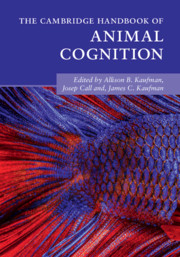Book contents
- The Cambridge Handbook of Animal Cognition
- The Cambridge Handbook of Animal Cognition
- Copyright page
- Dedication
- Contents
- Figures, Tables, and Boxes
- Contributors
- Acknowledgments
- Introduction
- Part I Communication and Language
- Part II Memory and Recall
- Part III Social Cognition
- Part IV Social Learning and Teaching
- Part V Numerical and Quantitative Abilities
- Part VI Innovation and Problem-Solving
- 28 Innovation and Problem-Solving Overview
- 29 General Intelligence (g) in Mice
- 30 Bowerbird Innovation and Problem-Solving
- 31 Parrot Innovation
- 32 Innovation in Marine Mammals
- 33 Innovation in Capuchin Monkeys
- 34 Innovation and Problem-Solving in Orangutans
- 35 Do Apes and Monkeys Know What They (Don’t) Know?
- 36 Decision Making in Animals
- Index
- References
30 - Bowerbird Innovation and Problem-Solving
from Part VI - Innovation and Problem-Solving
Published online by Cambridge University Press: 01 July 2021
- The Cambridge Handbook of Animal Cognition
- The Cambridge Handbook of Animal Cognition
- Copyright page
- Dedication
- Contents
- Figures, Tables, and Boxes
- Contributors
- Acknowledgments
- Introduction
- Part I Communication and Language
- Part II Memory and Recall
- Part III Social Cognition
- Part IV Social Learning and Teaching
- Part V Numerical and Quantitative Abilities
- Part VI Innovation and Problem-Solving
- 28 Innovation and Problem-Solving Overview
- 29 General Intelligence (g) in Mice
- 30 Bowerbird Innovation and Problem-Solving
- 31 Parrot Innovation
- 32 Innovation in Marine Mammals
- 33 Innovation in Capuchin Monkeys
- 34 Innovation and Problem-Solving in Orangutans
- 35 Do Apes and Monkeys Know What They (Don’t) Know?
- 36 Decision Making in Animals
- Index
- References
Summary
Behavioral innovation, the ability to invent new behaviors and/or use preexisting behaviors in a new context to respond to a novel situation, can be critical to an individual’s survival (i.e., natural selection). Less studied is how innovation can be critical for mating success (i.e., sexual selection). Bowerbirds are an excellent system to study the latter, given the likely importance of sexual selection to their diversification. Bowerbirds are a family of birds that show remarkable diversity in their unique construction of courtship arenas out of sticks and use of various colored objects as decorations. In this chapter, I give background on what bowerbirds are and present inadvertent evidence from experimental manipulations of their off-body sexual displays that bowerbirds are extremely flexible in their behavior. The bulk of the chapter reviews experiments in which novel problem-solving tasks were presented to bowerbirds and then their performance was compared to their mating success. I conclude by suggesting that an important future research goal should be to study how innovativeness affects the speciation process via sexual selection.
- Type
- Chapter
- Information
- The Cambridge Handbook of Animal Cognition , pp. 667 - 689Publisher: Cambridge University PressPrint publication year: 2021



